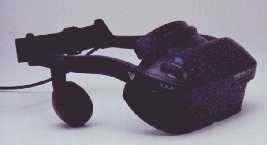| Rivalry and Interference with a Head Mounted Display |

|
Two backgrounds were used. A dynamic moving background was provided by a large screen TV while an untidy bookshelf was used to provide a complex static background. With the TV background large effects were found attributable to both rivalry and visual interference. These two effects were roughly additive. Smaller effects were found with the bookshelf. In conclusion we suggest that monocular transparent HMDs may be unsuitable for use in visually dynamic environments. However when backgrounds are relatively static, having a transparent display may be preferable to having an opaque display.
The head mounted display we worked with looked like this. We removed one eye piece (the right eye) in order to make it monocular.
This figure shows text at one focal distance, and background objects at three different simulated focal distances. The fruit which is closer to the focal distance of the text makes the text harder to read whereas the text in front of the tree is easier to read.
Average response time versus each of 9 HMD configurations. The configurations are labeled with (1) the number of viewing eyes (2) the HMD opacity (or transparency) and (3) the type of background (bookshelf or TV) e.g. binocular, opaque, bookshelf